Abstract
In order to illustrate pollution characterization, source apportionment, and risk assessment of VOCs in Beijing, Baoding, and Shanghai, field observations of CO, NO, NO2, O3, and volatile organic compounds (VOCs) were conducted in 2019. Concentrations of VOCs were the highest in Beijing (105.4 ± 52.1 ppb), followed by Baoding (97.1 ± 47.5 ppb) and Shanghai (91.1 ± 41.3 ppb). Concentrations of VOCs were the highest in winter (120.3 ± 61.5 ppb) among the three seasons tested, followed by summer (98.1 + 50.8 ppb) and autumn (75.5 + 33.4 ppb). Alkenes were the most reactive VOC species in all cities, accounting for 56.0%, 53.7%, and 39.4% of ozone formation potential in Beijing, Baoding, and Shanghai, respectively. Alkenes and aromatics were the reactive species, particularly ethene, propene, 1,3,5-trimethylbenzene, and m/p-xylene. Vehicular exhaust was the principal source in all three cities, accounting for 27.0%, 30.4%, and 23.3% of VOCs in Beijing, Baoding, and Shanghai, respectively. Industrial manufacturing was the second largest source in Baoding (23.6%) and Shanghai (21.3%), and solvent utilization was the second largest source in Beijing (25.1%). The empirical kinetic modeling approach showed that O3 formation was limited by both VOCs and nitric oxides at Fangshan (the suburban site) and by VOCs at Xuhui (the urban site). Acrolein was the only substance with an average hazard quotient greater than 1, indicating significant non-carcinogenic risk. In Beijing, 1,2-dibromoethane had an R-value of 1.1 × 10−4 and posed a definite carcinogenic risk.
1. Introduction
In September 2013, the Chinese government implemented the Action Plan on Air Pollution Prevention and Control, resulting in significant reductions in ambient concentrations of CO, SO2, NO2, and fine particulate levels nationwide [1,2,3]. However, O3 pollution has not decreased and appears to be worsening in China. The O3 concentration showed an increasing trend of 1–3 ppbv/y from 2013 to 2017 in eastern China [4]. Volatile organic compounds (VOCs) and nitrogen oxides (NOx) are the main precursors of O3. The relationship between O3 and its precursors is highly nonlinear due to the complex photochemical reactions that occur in the atmosphere [5,6,7]. Conditions for forming ground-level O3 can be divided into VOC-limited, NOx-limited, and both VOC- and NOx-limited [8]. In most developed areas of China, including the Yangtze River Delta, Jing-Jin-Ji, and Pearl River Delta regions, O3 formation is reported to be VOC-limited [9,10,11]. Thus, controlling VOC emissions is critical for reducing O3 pollution in China.
High concentrations of VOCs have adverse effects on public health by affecting the respiratory and cardiovascular systems [12,13,14,15,16]. Previous studies showed that cancer risk is greater in high-VOC-exposure areas than in clean areas [17,18]. Hazardous VOCs, including non-carcinogens and carcinogens, account for 20–40% of all non-methane VOCs in China [19]. Many VOC species, including benzene and 1,3-Butadiene, are classified as hazardous air pollutants by the United States Environmental Protection Agency (USEPA) and other international agencies [20,21,22,23].
The Beijing–Tianjin–Hebei (BTH) and Yangtze River Delta (YRD) regions are two of the largest urban agglomerations in China. Numerous studies of VOCs have been performed in BTH and YRD. Several studies have examined the general characteristics of VOCs and discussed their spatiotemporal variations [24,25,26,27,28]. Other studies have focused on the relative reactivity and ozone formation potential (OFP) of VOCs [29,30,31,32]. Several studies have aimed to reveal the health effects of VOCs [33,34,35,36,37,38]. Additionally, the emission inventory [39], regional transport [36,40,41,42], and source apportionment [26,43,44,45,46] of VOCs have been discussed.
Beijing, the capital of China, and Baoding, one of the most air-polluted cities, are both located in the BTH region. Shanghai is one of the most economically developed cities in the YRD and has relatively concentrated energy consumption and pollutant emissions. Most previous studies have been limited to a small number of sampling locations or a short sampling period. In this study, field observations of CO, NO, NO2, O3, and VOCs were conducted in these three megacities. The main objectives of this study were to: (1) characterize the concentrations and spatiotemporal variations of VOCs; (2) discuss the regional transport and source apportionment of VOCs; (3) determine the roles of VOCs in ground-level O3 formation; (4) estimate the carcinogenic and non-carcinogenic risks of VOCs; and (5) identify the key hazardous VOCs in the three cities.
2. Methodology
2.1. Sampling Site and Period
Ten sites in the three cities were selected for this study, among which four were in Beijing, three were in Baoding, and three were in Shanghai (Figure 1). The sampling sites in each city included a background site, an urban site, and a suburban site. A continuous 2-week period in each of the four seasons was selected. However, due to the COVID-19 crisis, sampling in the spring was terminated. Thus, the sampling periods were 15–28 August in the summer, 13–26 October in the autumn, and 18–31 December in the winter of 2019.
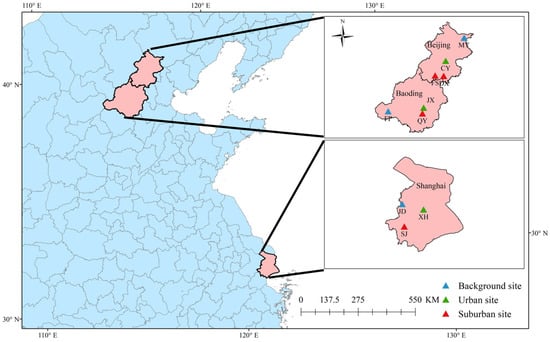
Figure 1.
Sites sampled in this study. MY, FP, and JD are background sites. CY, JX, and XH are urban sites. FS, DX, QY, and SJ are suburban sites.
2.2. Sampling and Analysis
CO, NO, NO2, and O3 were observed using a sensor-based air monitoring instrument developed by the Chinese Research Academy of Environmental Sciences. This instrument passed an intercomparison assessment with an instrument produced by TSI Corporations. The correlation coefficient was 0.92, and the two instruments’ relative error was 8%. VOCs were sampled at 16:00 at each site using a 3.2-L Summa canister (Entech Instruments Inc., Simi Valley, CA, USA). In total, 99 VOCs were observed, including 29 alkanes, 13 alkenes, 1 alkyne (acetylene), 16 aromatics, 32 haloalkanes, and 8 oxygenated VOCs (OVOCs). VOC samples were analyzed using the Agilent 5973N gas chromatography–mass selective detector flame ionization detector (Agilent Technologies, Santa Clara, CA, USA). A liquid nitrogen primary cryogenic trap with glass beads at −160 °C was used to trap VOCs. Then, the trap was heated to 10 °C, and target compounds were transferred to a secondary trap at −50 °C. Next, the VOCs were transferred using helium to a third trap at −170 °C. A DB-1 capillary column (60 m × 0.32 mm × 1.0 μm, Agilent Inc.) was used with helium as the carrier gas. Rigorous quality assurance and quality control procedures were employed. Periodic calibration was performed every 5 d. Calibration curve results for a given target species with less than 10% variation relative to the actual values were considered acceptable. Meteorological data were obtained from the China Meteorological Station Data Sharing Service System (http://cdc.cma.gov.cn/home.do, accessed on 5 January 2021).
2.3. Determination of the Ozone Formation Potential
The OFP can be used to characterize the maximum amount of O3 production possible from a given VOC species alone under optimal conditions. The key compounds responsible for O3 formation can be determined from the respective OFPs [38]. The OFPs are calculated based on the maximum incremental reactivity (MIR) of each individual species and given by the following equation:
where OFPi is the OFP of VOC species i, VOCsi is the concentration of VOC species i, and MIRi is the O3 formation coefficient for VOC species i at the maximum incremental reactivity of O3 [47].
OFPi = VOCsi × MIRi
2.4. Positive Matrix Factorization Receptor Model
The sources of PM2.5 were analyzed using the positive matrix factorization (PMF) receptor model. First, the error associated with the chemical component weights of the receptor was determined. Then, the main sources of contamination and their contribution ratios were determined using the least squares method. PMF is a type of multivariate factor analysis in which a mathematical method decomposes matrix X containing sample data for a given species into two matrices: factor contributions (G) and factor spectra (F). This method does not require the input of a source spectrum and ensures that the decomposition factor contribution (G) and factor spectrum (F) are non-negative [48]. The following formula represents the matrix X:
where is the concentration of species j in sample , p is the number of factors, is the contribution of factor k to sample , is the contribution of factor k to species j, and is the error of species j in sample .
The uncertainty of a sample was calculated from the error fraction and the method detection limit (MDL). If the concentration was unknown, it was set to 1/2 of the geometric mean value. If the concentration was below the MDL, it was set to 1/2 of the MDL, and the uncertainty was set to 5/6 of the MDL. If the concentration was higher than the MDL, the uncertainty calculation was based on the error fraction as follows:
The PMF analysis depends on the objective function (Q) to minimize the residual and uncertainty, as shown in Equation (4). The calculation of Qexp is shown in Equation (5).
where n and m are the numbers of species and samples, respectively, and uij is the uncertainty of the jth species in the ith sample.
Several aspects were considered to define a reasonable result (Liu et al., 2021) [22]: (1) the value of Q/Qexp from PMF should be close to one; (2) the change rate of Q/Qexp should be stable; and (3) the explored factors should be physically plausible and interpretable. Ultimately, a five-factor solution was determined in this study. The Q/Qexp values were 1.3, 1.4, and 1.4 for Beijing, Baoding, and Shanghai, respectively.
2.5. Potential Source Contribution Function
The potential source contribution function (PSCF) was employed in this study using the software Meteoinfo (3.6.3) to identify the local and long-range transport pathways of VOCs. The PSCF is a backward-trajectory-based method that combines pollutant concentrations, reflecting the potential for this area to become a source of VOC pollution [49]. The PSCF is a position function defined by unit indexes i and j:
where nij is the number of trajectory endpoints that fall within the ijth grid cell, mij is the number of endpoints corresponding to trajectories that exceed the threshold criterion at the receptor site [50], and ij is the grid cell. The arbitrary weighting function Wij was applied to reduce the uncertainty caused by small values of nij:
where nave is the average value of the endpoints of the trajectory through all the grids. In this study, the nave was 1.33, 1.31, and 1.19 for Fangshan, Jiading, and Jingxiu sites, respectively. In this study, the 24-h backward trajectory was calculated at 1-h intervals according to Beijing local time (UTC + 8). The arrival height was set to 100 m above the ground. Meteorological data were obtained from the National Oceanic and Atmospheric Administration (ftp://arlftp.arlhq.noaa.gov/pub/archives/gdas0p5/, accessed on 6 January 2021) with a grid resolution of 0.25° × 0.25°. The threshold value was the average VOC concentration during the observation (Beijing 105.4 ppb, Baoding 97.1 ppb, Shanghai 91.1 ppb). The total number of trajectories was 1008 at each site.
2.6. Observation-Based Model
The observation-based model (OBM) was used in this study in combination with the Master Chemical Mechanism (v3.3.1; http://mcm.leeds.ac.uk/MCM/, accessed on 10 January 2021), a near-explicit mechanism describing the oxidation reactions of 146 primary VOCs and the latest inorganic chemistry data from the International Union of Pure and Applied Chemistry evaluation [51]. The OBM has been widely used to identify photochemical reactivity and photochemical products in various environments [52]. Hourly concentrations of the observed VOCs and four trace gases (CO, NO, NO2, and SO2) and hourly meteorological parameters (temperature and relative humidity) were used as input data. The instantaneous concentration of VOCs was converted to hourly concentrations according to the linear regressions with CO, following the method by Yang et al. [53]. The OBM assesses the sensitivity of O3 photochemical production by calculating the relative incremental reactivity and altering the concentrations of its precursors without requiring detailed or accurate knowledge about these emissions [54]:
where X is a precursor of O3, ΔX is the change in the concentration of X, P(O3) represents the net O3 production rate, S(X) is the measured concentration of precursor X, and ΔS(X)/S(X) represents the relative change in S(X), which was 20% in this study.
2.7. Human Health Risk Assessment
The USEPA proposed a method that uses the ambient mass concentration of air pollutants as an exposure evaluation parameter. The health risk of VOCs is divided into non-carcinogenic and carcinogenic risks, which are represented by the hazard quotient (HQ) and the lifetime carcinogenic risk (R), respectively [55]. An HQ less than 1 indicates no significant non-carcinogenic risk for adults, and an R-value less than 1 × 10−6 suggests an acceptable carcinogenic risk [38]. The specific calculation is shown in the Supplemental Material File.
3. Results and Discussion
3.1. Chemical Characteristics of Volatile Organic Compounds
The concentrations of VOCs were the highest in winter (120.3 ± 61.5 ppb) among the three seasons assessed, followed by summer (98.1 ± 50.8 ppb) and autumn (75.5 ± 33.4 ppb), as shown in Figure 2. However, total VOCs were similar in the winter. In Baoding, VOC concentrations in the winter were significantly higher than those in the summer and autumn. VOC concentrations in the winter were 1.9 times those in the summer in Baoding. Baoding is a city of heavy industry, and the increase in industrial and heating emissions in the winter has led to an increase in VOC concentrations. VOC concentrations in the winter were close to those in the summer in Beijing and Shanghai. High temperatures and high solar radiation lead to higher solvent volatilization and plant-related VOC emissions in the summer. VOC concentrations in the autumn were the lowest of the three seasons.
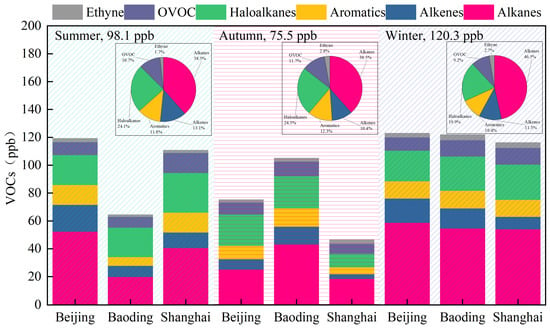
Figure 2.
Concentrations and chemical characteristics of VOCs in different seasons during the observation period.
Alkanes were the dominant VOC species in all seasons, especially winter, exceeding 40% of the total (see Figure 3). The concentrations of haloalkanes were the second highest, and their proportion among the other VOCs decreased in the winter. The concentrations of alkenes were highest in the summer, and those of OVOCs and aromatics were highest in the autumn. The concentration of alkenes was higher in Beijing, and that of OVOCs was higher in Shanghai. The aromatic concentrations were at similar proportions in all three cities. VOC concentrations were highest in Beijing (105.4 ± 52.1 ppb), followed by Baoding (97.1 ± 47.5 ppb) and Shanghai (91.1 ± 41.3 ppb). The VOC concentrations in Beijing were 1.09 and 1.16 times those in Baoding and Shanghai, respectively. There were few differences in VOC concentrations throughout the year among the three cities. The differences in VOCs among cities were related to air pollutant emissions, sampling locations, and meteorological conditions.
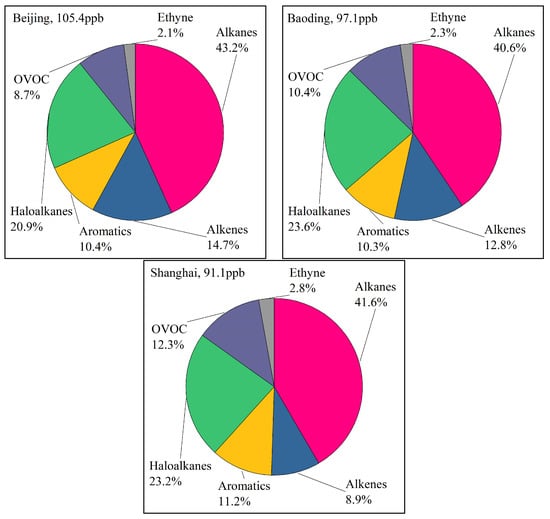
Figure 3.
Chemical characteristics of VOCs observed in the three cities.
Table 1 provides a comparison of the monitoring results from this study with previous observations of VOC species. The ethane, ethylene, propane, and acetylene concentrations in Shanghai were higher than those in previous reports. The concentrations of toluene and benzene in Shanghai were lower, and those of ethane and propane in Beijing were higher than those in previous studies. The ethylene, acetylene, and toluene concentrations in Beijing are similar to previously reported levels. The concentrations of VOC species in Baoding were higher than those in previous studies. Although the COVID-19 pandemic lockdown had a certain influence on industrial production in China, the concentration of VOC species did not show an obvious decreasing trend.

Table 1.
Comparison of the monitoring results for VOC species between the present study and previous reports.
3.2. The Ozone Formation Potential of Volatile Organic Compounds
The OFP values of VOC species at the sampling sites were calculated (see Figure 4). Both VOCs and VOC OFP were at their maximum in Beijing. The concentrations of VOCs in Baoding and Shanghai were similar, but the OFP values were significantly lower in Shanghai than in Baoding. Alkenes were the most reactive species of VOCs in all cities, accounting for 56.0%, 53.7%, and 39.4% of the OFP in Beijing, Baoding, and Shanghai, respectively. Aromatics were the second most reactive species of VOCs, accounting for 20.7%, 21.0%, and 28.3% of the OFP in Beijing, Baoding, and Shanghai, respectively.
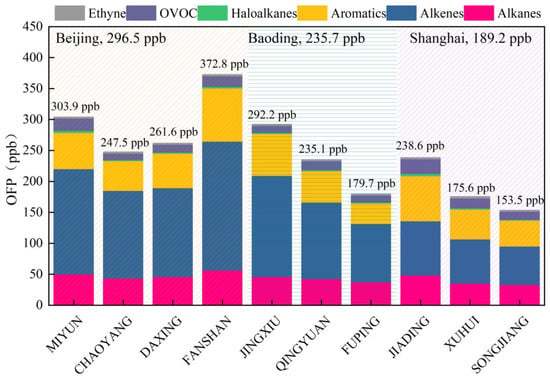
Figure 4.
OFPs of VOC species at all sampling sites.
Notably, the OFP values of VOCs at Fangshan, a suburban site near a petrochemical plant, were the highest in Beijing. The OFP of VOCs at the urban Jingxiu site were the highest in Baoding. The OFPs of VOCs at Jiading, a background site, were the highest among sites in Shanghai. The top 10 VOC species with regard to OFP were identified and are shown in Table 2. The most reactive species were alkenes and aromatics, particularly ethene, propene, 1,3,5-trimethylbenzene, and m/p-xylene. The emission sources of these species should be strictly controlled.

Table 2.
Top 10 VOC species with the highest OFP values in the three cities.
3.3. Potential Source Areas of Volatile Organic Compounds
The Fangshan, Jingxiu, and Jiading sites were selected for source area analysis due to their high VOC concentrations and OFP values. The potential source areas of VOCs for the three cities were simulated, as shown in Figure 5. Three main potential source areas of VOCs for Fangshan were identified: the southeast region along the border of Beijing, Tianjin, and Hebei; the southwest region along the Taihang Mountains; and the western region. Two main potential source areas of VOCs were identified for Jingxiu: the northeast region near Beijing and the southeast region in Hebei. The potential source areas of VOCs for Jiading were located around the site and at sea. VOCs can be transported to and from the sea via airflow and ship emissions.
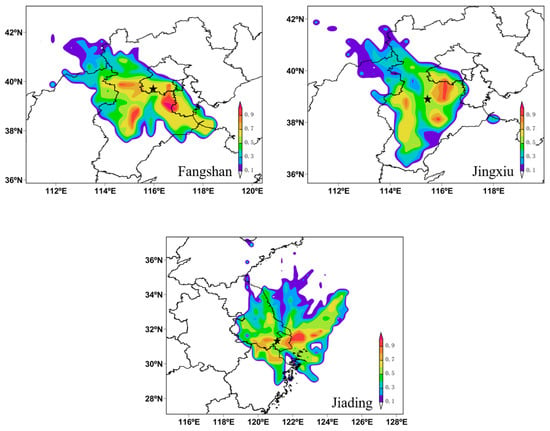
Figure 5.
Potential source areas of VOCs for the Fangshan, Jingxiu, and Jiading sites, the five-pointed star referred to the sampling sites.
3.4. Source Apportionment of Volatile Organic Compounds
We did not analyze species with a concentration below the MDL more than 50% of the time or with a significantly low signal-to-noise ratio [2,12]. After screening, 53 compounds in Beijing and Baoding and 47 compounds in Shanghai were selected. Five sources (vehicular exhaust, industrial manufacturing, solvent utilization, fuel combustion, and biogenic VOCs) were identified using the PMF model. Modeled source profiles and the relative contributions of individual sources to each species analyzed are shown in Figure 6.
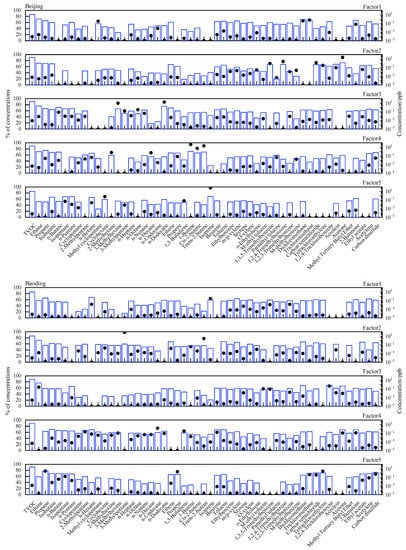
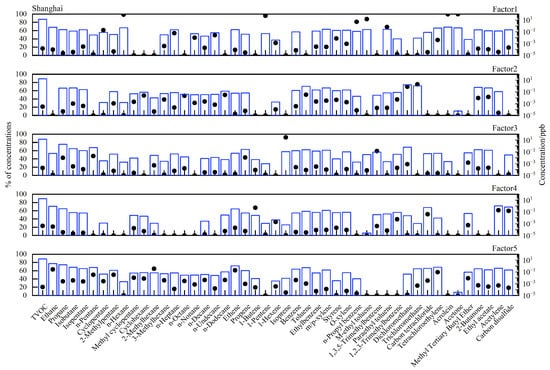
Figure 6.
Five source profiles (bars) and contribution percentages (dots) representing each source factor were resolved using the PMF model.
In the source profiles for Beijing, the first source was characterized by significant amounts of methyl cyclopentane, n-undecane toluene, and 2-butanone, which are representative of industrial manufacturing [57]. The second source was characterized by high concentrations of carbon tetrachloride, tetrachloroethylene, and acetone, which are widely used as solvents [58]. The third source was associated with high concentrations of acetylene and alkane, such as isopentane, n-octane, and n-dodecane, which are major species in vehicular emissions [59]. The fourth source profile was rich in 1-butene, propane, and 2-methylhexane, tracers of fuel combustion [60]. The fifth source represented 97% of the total isoprene, considered the most important biogenic hydrocarbon [61].
In the source profiles for Baoding, the first source was characterized by a high concentration of isoprene(biogenic). The second source was characterized by significant amounts of 3-methylpentane, trans-2-butene, and 1-butene, which are representative of fuel combustion. The third source was associated with high concentrations of 1,2,4-trichlorobenzene and acetone, widely used as solvents. The fourth source profile was rich in benzene, toluene, n-undecane, and n-nonane, major species emitted from industrial manufacturing. The fifth source was characterized by high concentrations of acetylene, propane, and propene, tracers of vehicular exhaust.
In the source profiles for Shanghai, the first source was characterized by significant amounts of acetone, n-propyl benzene, and tetrachloroethylene, which are widely used as solvents. The second source profile was rich in dichloromethane, trichloromethane, toluene, and n-dodecane, major species emitted from industrial manufacturing. The third source represented 92% of the total isoprene, considered the most important biogenic hydrocarbon. The fourth source was characterized by high concentrations of 1-butene and 1-hexene, which are representative of fuel combustion. The fifth source was associated with high concentrations of methyl tertiary butyl ether, ethene, and ethane, major species emitted in vehicular exhaust.
Figure 7 illustrates the percentage source contributions during the sampling period in the three cities. Vehicular exhaust was the largest contributor in all three cities, accounting for 27.0%, 30.4%, and 23.3% of VOCs in Beijing, Baoding, and Shanghai, respectively. Industrial manufacturing was the second largest contributor in Baoding (23.6%) and Shanghai (21.3%), and solvent utilization was the second largest contributor in Beijing (25.1%). Fuel combustion was the third largest contributor in Beijing (23.2%) and Shanghai (20.7%), and solvent utilization was the third largest contributor in Baoding (20.0%). Biogenic sources of VOCs were also important, accounting for 11.5%, 11.9%, and 18.1% of VOCs in Beijing, Baoding, and Shanghai, respectively.
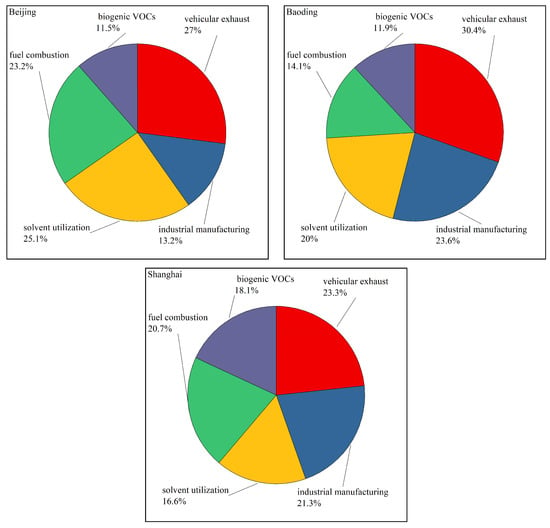
Figure 7.
Source apportionment results for VOCs in the three cities.
3.5. Empirical Kinetic Modeling Approach
Meteorological data for the Fangshan and Xuhui sites were obtained from the China Meteorological Station Data Sharing Service System. Thus, the empirical kinetic modeling approach (EKMA) curves for those two sites in the summer period were simulated using the OBM model, as shown in Figure 8. During the sampling period in summer, the average temperature and relative humidity were 30.4 °C and 60% in Fangshan and 31.5 °C and 71% in Xuhui. The EKMA plot was split into two areas by a ridgeline denoting the local maxima in the rate of O3 formation. The upper–left and lower–right areas represent O3 formation under VOC-limited and NOx-limited conditions, respectively. The base scenario point for the Fangshan site is located near the ridgeline, indicating a VOCs- and NOx-limited condition. The base scenario point for the Xuhui site is located in the upper-left area, indicating VOCs limitation. Fangshan is a suburban site, and Xuhui is an urban site. Previous studies have reported that urban and suburban areas in China were under VOC-limited and both VOC- and NOx-limited conditions [8,62], respectively.
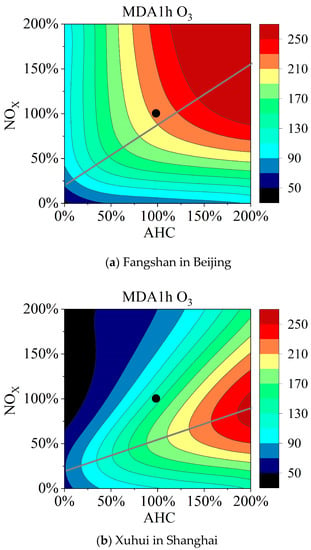
Figure 8.
EKMA graphs for suburban Beijing and urban Shanghai. The black dot represents the base scenario, and the gray line represents the ridgeline of the EKMA curve. The AHC represents anthropogenic VOCs. The MDA 1 h O3 represents the daily maximum 1 h average O3 concentration.
3.6. Health Risk Assessment of Volatile Organic Compounds
Forty-four species were targeted for health risk assessment, and their non-carcinogenic and carcinogenic risks are presented in Figure 9. The USEPA states that pollutants with an HQ of less than 1 pose no significant non-carcinogenic risk to adults. In this study, the average HQ values of the selected VOC species ranged from 5.3 × 10−6 to 16.9 × 10−6 in Beijing, 4.8 × 10−6 to 8.9 × 10−6 in Baoding, and 8.8 × 10−6 to 18.3 × 10−6 in Shanghai. Acrolein was the only substance with an average HQ value greater than 1, indicating significant non-carcinogenic risk. VOC species with carcinogenic risks of >10−4, 10−5 to 10−4, 10−5 to 10−6, and <10−6 are classified as definite, probable, possible, and negligible risks, respectively [63]. In this study, the average R-value for the selected VOC species ranged from 4.7 × 10−9 to 1.1 × 10−4 in Beijing, from 6.7 × 10−9 to 6.2 × 10−5 in Baoding, and from 3.9 × 10−9 to 7.9 × 10−5 in Shanghai. In Beijing, 1,2-dibromoethane had an R-value of 1.1 × 10−4, posing a definite carcinogenic risk. Five, seven, and six VOC species posed probable carcinogenic risks in Beijing, Baoding, and Shanghai, respectively. Six, four, and six VOC species posed possible carcinogenic risks in Beijing, Baoding, and Shanghai, respectively. Among these species, hexachloro-1,3-butadiene, trichloromethane, 1,2-dichloroethane, and carbon tetrachloride posed high carcinogenic risks in all three cities.
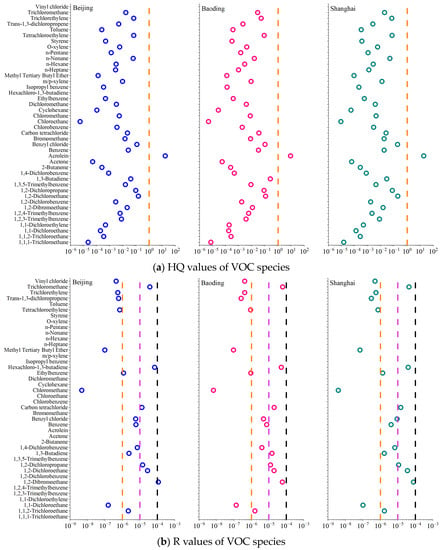
Figure 9.
Non-carcinogenic and carcinogenic risks of VOC species in the three cities.
4. Conclusions
In this study, field observations of CO, NO, NO2, O3, and VOCs were conducted in three megacities in China: Beijing, Baoding, and Shanghai. VOC concentrations were highest in Beijing (105.4 ± 52.1 ppb), followed by Baoding (97.1 ± 47.5 ppb) and Shanghai (91.1 ± 41.3 ppb). VOC concentrations were highest in winter (120.3 ± 61.5 ppb) among the three seasons assessed, followed by summer (98.1 ± 50.8 ppb) and autumn (75.5 ± 33.4 ppb). Alkanes were the dominant species in all three cities, with concentrations exceeding 40%.
Alkenes were the most reactive VOC species in all three cities, accounting for 56.0%, 53.7%, and 39.4% of the OFP in Beijing, Baoding, and Shanghai, respectively. Aromatics were the second most reactive VOC species in all cities, accounting for 20.7%, 21.0%, and 28.3% of the OFP in Beijing, Baoding, and Shanghai, respectively. Most reactive species were alkenes and aromatics, particularly ethene, propene, 1,3,5-trimethylbenzene, and m/p-xylene.
Vehicular exhaust was the largest VOC source in all three cities, accounting for 27.0%, 30.4%, and 23.3% of VOCs in Beijing, Baoding, and Shanghai, respectively. Industrial manufacturing was the second largest contributor in Baoding (23.6%) and Shanghai (21.3%), and solvent utilization was the second largest contributor in Beijing (25.1%). Biogenic VOCs were also important, accounting for 11.5%, 11.9%, and 18.1% of VOCs in Beijing, Baoding, and Shanghai, respectively.
The EKMA approach indicated that O3 formation at the Fangshan site was limited by both VOCs and NOx, while that at the Xuhui site was limited by VOCs. Acrolein was the only substance with an average HQ value greater than 1, indicating a significant non-carcinogenic risk. In Beijing, 1,2-dibromoethane had an R-value of 1.1 × 10−4, posing a definite carcinogenic risk. Hexachloro-1,3-butadiene, trichloromethane, 1,2-dichloroethane, and carbon tetrachloride posed high carcinogenic risks in all three cities.
Supplementary Materials
The following supporting information can be downloaded at: https://www.mdpi.com/article/10.3390/toxics11080651/s1, Table S1: RfC and IUR values of selected VOC species in this study [64].
Author Contributions
Z.W.: conceptualization, methodology, formal analysis, investigation, writing—original draft preparation, and visualization. P.Z.: conceptualization, validation, investigation, and writing—review and editing. Y.Q.: conceptualization, methodology, formal analysis, investigation, writing—original draft preparation, and visualization. Z.L.: conceptualization, methodology, formal analysis, investigation, writing—original draft preparation, and visualization. X.L.: software, investigation, and resources. C.G. and X.Z.: software, investigation, and resources. Y.X.: conceptualization, methodology, validation, writing—review and editing, and supervision. L.P. and Y.W.: conceptualization, methodology, formal analysis, investigation, writing—original draft preparation, and visualization. All authors have read and agreed to the published version of the manuscript.
Funding
This work was funded by the National Key R&D Program of China (2022YFE0209500), the National Natural Science Foundation of China (No. 41705112), and the China Prospective Cohort Study of Air Pollution and Health Effects in Typical Areas (C-PAT) (Grant No. MEE-EH-20190802).
Institutional Review Board Statement
Not applicable.
Informed Consent Statement
Not applicable.
Data Availability Statement
The data are available on request from the corresponding author.
Conflicts of Interest
The authors declare no conflict of interest.
References
- Shao, P.; Xu, X.; Zhang, X.; Xu, J.; Wang, Y.; Ma, Z. Impact of volatile organic compounds and photochemical activities on particulate matters during a high ozone episode at urban, suburb and regional background stations in Beijing. Atmos. Environ. 2020, 236, 117629. [Google Scholar] [CrossRef]
- Zhang, Z.; Man, H.; Qi, L.; Wang, X.; Liu, H.; Zhao, J.; Wang, H.; Jing, S.; He, T.; Wang, S.; et al. Measurement and minutely-resolved source apportionment of ambient VOCs in a corridor city during 2019 China International Import Expo episode. Sci. Total Environ. 2021, 798, 149375. [Google Scholar] [CrossRef] [PubMed]
- Zheng, H.; Kong, S.; Chen, N.; Niu, Z.; Zhang, Y.; Jiang, S.; Yan, Y.; Qi, S. Source apportionment of volatile organic compounds: Implications to reactivity, ozone formation, and secondary organic aerosol potential. Atmos. Res. 2021, 249, 105344. [Google Scholar] [CrossRef]
- Li, K.; Jacob, D.J.; Liao, H.; Shen, L.; Zhang, Q.; Bates, K.H. Anthropogenic drivers of 2013–2017 trends in summer surface ozone in China. Proc. Natl. Acad. Sci. USA 2019, 116, 422–427. [Google Scholar] [CrossRef]
- Chang, C.-T.; Lee, C.-H.; Wu, Y.-P.; Jeng, F.-T. Assessment of the strategies for reducing volatile organic compound emissions in the automotive industry in Taiwan. Resour. Conserv. Recycl. 2002, 34, 117–128. [Google Scholar] [CrossRef]
- Monti, M.; Perin, E.; Conterosito, E.; Romagnolli, U.; Muscato, B.; Girotto, M.; Scrivani, M.T.; Gianotti, V. Development of an advanced extrusion process for the reduction of volatile and semi-volatile organic compounds of recycled HDPE from fuel tanks. Resour. Conserv. Recycl. 2023, 188, 106691. [Google Scholar] [CrossRef]
- Zhang, K.; Li, L.; Huang, L.; Wang, Y.; Huo, J.; Duan, Y.; Wang, Y.; Fu, Q. The impact of volatile organic compounds on ozone formation in the suburban area of Shanghai. Atmos. Environ. 2020, 232, 117511. [Google Scholar] [CrossRef]
- Wang, T.; Xue, L.; Brimblecombe, P.; Lam, Y.F.; Li, L.; Zhang, L. Ozone pollution in China: A review of concentrations, meteorological influences, chemical precursors, and effects. Sci. Total Environ. 2017, 575, 1582–1596. [Google Scholar] [CrossRef] [PubMed]
- Geng, F.; Tie, X.; Xu, J.; Zhou, G.; Peng, L.; Gao, W.; Tang, X.; Zhao, C. Characterizations of ozone, NOx, and VOCs measured in Shanghai, China. Atmos. Environ. 2008, 42, 6873–6883. [Google Scholar] [CrossRef]
- Shao, M.; Zhang, Y.; Zeng, L.; Tang, X.; Zhang, J.; Zhong, L.; Wang, B. Ground-level ozone in the Pearl River Delta and the roles of VOC and NOx in its production. J. Environ. Manag. 2009, 90, 512–518. [Google Scholar] [CrossRef]
- Xing, J.; Wang, S.X.; Jang, C.; Zhu, Y.; Hao, J.M. Nonlinear response of ozone to precursor emission Changes in China: A modeling study using response surface methodology. Atmos. Chem. Phys. 2010, 11, 5027–5044. [Google Scholar] [CrossRef]
- Li, C.; Liu, Y.; Cheng, B.; Zhang, Y.; Liu, X.; Qu, Y.; An, J.; Kong, L.; Zhang, Y.; Zhang, C.; et al. A comprehensive investigation on volatile organic compounds (VOCs) in 2018 in Beijing, China: Characteristics, sources and behaviours in response to O3 formation. Sci. Total Environ. 2022, 806, 150247. [Google Scholar] [CrossRef]
- Xiu, M.; Wang, X.; Morawska, L.; Pass, D.; Beecroft, A.; Mueller, J.F.; Thai, P. Emissions of particulate matters, volatile organic compounds and polycyclic aromatic hydrocarbons from warm and hot asphalt mixes. J. Clean. Prod. 2020, 275, 123094. [Google Scholar] [CrossRef]
- Yang, Y.; Liu, B.; Hua, J.; Yang, T.; Dai, Q.; Wu, J.; Feng, Y.; Hopke, P.K. Global review of source apportionment of volatile organic compounds based on highly time-resolved data from 2015 to 2021. Environ. Int. 2022, 165, 107330. [Google Scholar] [CrossRef] [PubMed]
- Yin, Y.; He, J.; Zhao, L.; Pei, J.; Yang, X.; Sun, Y.; Cui, X.; Lin, C.-H.; Wei, D.; Chen, Q. Identification of key volatile organic compounds in aircraft cabins and associated inhalation health risks. Environ. Int. 2022, 158, 106999. [Google Scholar] [CrossRef] [PubMed]
- Zhang, K.; Chang, S.; Wang, E.; Zhang, Q.; Fan, Y.; Bai, Y.; Zhang, M.; Fu, Q.; Jia, W. Occurrence, health risk, and removal efficiency assessment of volatile organic compounds in drinking water treatment plants (DWTPs): An investigation of seven major river basins across China. J. Clean. Prod. 2022, 372, 133762. [Google Scholar] [CrossRef]
- Duan, C.; Liao, H.; Wang, K.; Ren, Y. The research hotspots and trends of volatile organic compound emissions from anthropogenic and natural sources: A systematic quantitative review. Environ. Res. 2023, 216, 114386. [Google Scholar]
- Hajizadeh, Y.; Teiri, H.; Nazmara, S.; Parseh, I. Environmental and biological monitoring of exposures to VOCs in a petrochemical complex in Iran. Environ. Sci. Pollut. Res. 2018, 25, 6656–6667. [Google Scholar] [CrossRef]
- Zheng, B.; Tong, D.; Li, M.; Liu, F.; Zhang, Q. Trends in China’s anthropogenic emissions since 2010 as the consequence of clean air actions. Atmos. Chem. Phys. 2018, 18, 14095–14111. [Google Scholar] [CrossRef]
- Cheng, C.-A.; Ching, T.-C.; Tsai, S.-W.; Chuang, K.-J.; Chuang, H.-C.; Chang, T.-Y. Exposure and health risk assessment of indoor volatile organic compounds in a medical university. Environ. Res. 2022, 213, 113644. [Google Scholar] [CrossRef]
- Huang, H.; Wang, Z.; Dai, C.; Guo, J.; Zhang, X. Volatile organic compounds emission in the rubber products manufacturing processes. Environ. Res. 2022, 212, 113485. [Google Scholar] [CrossRef]
- Liu, Y.; Kong, L.; Liu, X.; Zhang, Y.; Li, C.; Zhang, Y.; Zhang, C.; Qu, Y.; An, J.; Ma, D.; et al. Characteristics, secondary transformation, and health risk assessment of ambient volatile organic compounds (VOCs) in urban Beijing, China. Atmos. Pollut. Res. 2021, 12, 33–46. [Google Scholar] [CrossRef]
- Singh, B.P.; Sohrab, S.S.; Athar, M.; Alandijany, T.A.; Kumari, S.; Nair, A.; Kumari, S.; Mehra, K.; Chowdhary, K.; Rahman, S.; et al. Substantial Changes in Selected Volatile Organic Compounds (VOCs) and Associations with Health Risk Assessments in Industrial Areas during the COVID-19 Pandemic. Toxics 2023, 11, 165. [Google Scholar] [CrossRef]
- Acton, W.J.F.; Huang, Z.; Davison, B.; Drysdale, W.S.; Fu, P.; Hollaway, M.; Langford, B.; Lee, J.; Liu, Y.; Metzger, S.; et al. Surface–atmosphere fluxes of volatile organic compounds in Beijing. Atmos. Chem. Phys. 2020, 20, 15101–15125. [Google Scholar] [CrossRef]
- Geng, C.; Wang, J.; Yin, B.; Zhao, R.; Li, P.; Yang, W.; Xiao, Z.; Li, S.; Li, K.; Bai, Z. Vertical distribution of volatile organic compounds conducted by tethered balloon in the Beijing-Tianjin-Hebei region of China. J. Environ. Sci. 2020, 95, 121–129. [Google Scholar] [CrossRef]
- Li, J.; Xie, S.D.; Zeng, L.M.; Li, L.Y.; Li, Y.Q.; Wu, R.R. Characterization of ambient volatile organic compounds and their sources in Beijing, before, during, and after Asia-Pacific Economic Cooperation China 2014. Atmos. Chem. Phys. 2015, 15, 7945–7959. [Google Scholar] [CrossRef]
- Ling, Y.; Wang, Y.; Duan, J.; Xie, X.; Liu, Y.; Peng, Y.; Qiao, L.; Cheng, T.; Lou, S.; Wang, H.; et al. Long-term aerosol size distributions and the potential role of volatile organic compounds (VOCs) in new particle formation events in Shanghai. Atmos. Environ. 2019, 202, 345–356. [Google Scholar] [CrossRef]
- Wang, L.; Slowik, J.G.; Tong, Y.; Duan, J.; Gu, Y.; Rai, P.; Qi, L.; Stefenelli, G.; Baltensperger, U.; Huang, R.-J.; et al. Characteristics of wintertime VOCs in urban Beijing: Composition and source apportionment. Atmos. Environ. X 2021, 9, 100100. [Google Scholar] [CrossRef]
- Gao, J.; Zhang, J.; Li, H.; Li, L.; Xu, L.; Zhang, Y.; Wang, Z.; Wang, X.; Zhang, W.; Chen, Y.; et al. Comparative study of volatile organic compounds in ambient air using observed mixing ratios and initial mixing ratios taking chemical loss into account—A case study in a typical urban area in Beijing. Sci. Total Environ. 2018, 628–629, 791–804. [Google Scholar] [CrossRef] [PubMed]
- Han, T.; Ma, Z.; Li, Y.; Pu, W.; Wu, J.; Li, Z.; Shang, J.; He, D.; Zhou, L.; Wang, Y. Chemical characteristics and source apportionments of volatile organic compounds (VOCs) before and during the heating season at a regional background site in the North China Plain. Atmos. Res. 2021, 262, 105778. [Google Scholar] [CrossRef]
- Yang, S.; Li, X.; Song, M.; Liu, Y.; Yu, X.; Chen, S.; Lu, S.; Wang, W.; Yang, Y.; Zeng, L.; et al. Characteristics and sources of volatile organic compounds during pollution episodes and clean periods in the Beijing-Tianjin-Hebei region. Sci. Total Environ. 2021, 799, 149491. [Google Scholar] [CrossRef] [PubMed]
- Zhan, J.; Feng, Z.; Liu, P.; He, X.; He, Z.; Chen, T.; Wang, Y.; He, H.; Mu, Y.; Liu, Y. Ozone and SOA formation potential based on photochemical loss of VOCs during the Beijing summer. Environ. Pollut. 2021, 285, 117444. [Google Scholar] [CrossRef] [PubMed]
- Dai, H.; Jing, S.; Wang, H.; Ma, Y.; Li, L.; Song, W.; Kan, H. VOC characteristics and inhalation health risks in newly renovated residences in Shanghai, China. Sci. Total Environ. 2017, 577, 73–83. [Google Scholar] [CrossRef] [PubMed]
- Gong, Y.; Wei, Y.; Cheng, J.; Jiang, T.; Chen, L.; Xu, B. Health risk assessment and personal exposure to Volatile Organic Compounds (VOCs) in metro carriages—A case study in Shanghai, China. Sci. Total Environ. 2017, 574, 1432–1438. [Google Scholar] [CrossRef] [PubMed]
- Li, C.; Li, Q.; Tong, D.; Wang, Q.; Wu, M.; Sun, B.; Su, G.; Tan, L. Environmental impact and health risk assessment of volatile organic compound emissions during different seasons in Beijing. J. Environ. Sci. 2020, 93, 1–12. [Google Scholar] [CrossRef]
- Liu, Y.; Wang, H.; Jing, S.; Peng, Y.; Gao, Y.; Yan, R.; Wang, Q.; Lou, S.; Cheng, T.; Huang, C. Strong regional transport of volatile organic compounds (VOCs) during wintertime in Shanghai megacity of China. Atmos. Environ. 2021, 244, 117940. [Google Scholar] [CrossRef]
- Xie, F.; Zhou, X.; Wang, H.; Gao, J.; Hao, F.; He, J.; Lü, C. Heating events drive the seasonal patterns of volatile organic compounds in a typical semi-arid city. Sci. Total Environ. 2021, 788, 147781. [Google Scholar] [CrossRef]
- Yao, S.; Wang, Q.; Zhang, J.; Zhang, R.; Gao, Y.; Zhang, H.; Li, J.; Zhou, Z. Ambient volatile organic compounds in a heavy industrial city: Concentration, ozone formation potential, sources, and health risk assessment. Atmos. Pollut. Res. 2021, 12, 101053. [Google Scholar] [CrossRef]
- Shi, Y.; Xi, Z.; Simayi, M.; Li, J.; Xie, S. Scattered coal is the largest source of ambient volatile organic compounds during the heating season in Beijing. Atmos. Chem. Phys. 2020, 20, 9351–9369. [Google Scholar] [CrossRef]
- Wei, W.; Li, Y.; Wang, Y.; Cheng, S.; Wang, L. Characteristics of VOCs during haze and non-haze days in Beijing, China: Concentration, chemical degradation and regional transport impact. Atmos. Environ. 2018, 194, 134–145. [Google Scholar] [CrossRef]
- Xie, G.; Chen, H.; Zhang, F.; Shang, X.; Zhan, B.; Zeng, L.; Mu, Y.; Mellouki, A.; Tang, X.; Chen, J. Compositions, sources, and potential health risks of volatile organic compounds in the heavily polluted rural North China Plain during the heating season. Sci. Total Environ. 2021, 789, 147956. [Google Scholar] [CrossRef] [PubMed]
- Yang, W.; Zhang, Y.; Wang, X.; Li, S.; Zhu, M.; Yu, Q.; Li, G.; Huang, Z.; Zhang, H.; Wu, Z.; et al. Volatile organic compounds at a rural site in Beijing: Influence of temporary emission control and wintertime heating. Atmos. Chem. Phys. 2018, 18, 12663–12682. [Google Scholar] [CrossRef]
- Li, T.; Lu, G.; Lin, J.; Liang, D.; Hong, B.; Luo, S.; Wang, D.; Oeser, M. Volatile organic compounds (VOCs) inhibition and energy consumption reduction mechanisms of using isocyanate additive in bitumen chemical modification. J. Clean. Prod. 2022, 368, 133070. [Google Scholar] [CrossRef]
- Liu, Y.; Wang, H.; Jing, S.; Gao, Y.; Peng, Y.; Lou, S.; Cheng, T.; Tao, S.; Li, L.; Li, Y.; et al. Characteristics and sources of volatile organic compounds (VOCs) in Shanghai during summer: Implications of regional transport. Atmos. Environ. 2019, 215, 116902. [Google Scholar] [CrossRef]
- Norris, C.; Fang, L.; Barkjohn, K.K.; Carlson, D.; Zhang, Y.; Mo, J.; Li, Z.; Zhang, J.; Cui, X.; Schauer, J.J.; et al. Sources of volatile organic compounds in suburban homes in Shanghai, China, and the impact of air filtration on compound concentrations. Chemosphere 2019, 231, 256–268. [Google Scholar] [CrossRef]
- Zhang, Y.; Kong, S.; Sheng, J.; Zhao, D.; Ding, D.; Yao, L.; Zheng, H.; Wu, J.; Cheng, Y.; Yan, Q.; et al. Real-time emission and stage-dependent emission factors/ratios of specific volatile organic compounds from residential biomass combustion in China. Atmos. Res. 2021, 248, 105189. [Google Scholar] [CrossRef]
- Carter, W.P.L. Development of the SAPRC-07 chemical mechanism. Atmos. Environ. 2010, 44, 5324–5335. [Google Scholar] [CrossRef]
- Gu, Y.; Liu, B.; Dai, Q.; Zhang, Y.; Zhou, M.; Feng, Y.; Hopke, P.K. Multiply improved positive matrix factorization for source apportionment of volatile organic compounds during the COVID-19 shutdown in Tianjin, China. Environ. Int. 2022, 158, 106979. [Google Scholar] [CrossRef]
- Li, B.; Ho, S.S.H.; Li, X.; Guo, L.; Chen, A.; Hu, L.; Yang, Y.; Chen, D.; Lin, A.; Fang, X. A comprehensive review on anthropogenic volatile organic compounds (VOCs) emission estimates in China: Comparison and outlook. Environ. Int. 2021, 156, 106710. [Google Scholar] [CrossRef]
- Kong, X.; He, W.; Qin, N.; He, Q.; Yang, B.; Ouyang, H.; Wang, Q.; Xu, F. Comparison of transport pathways and potential sources of PM10 in two cities around a large Chinese lake using the modified trajectory analysis. Atmos. Res. 2013, 122, 284–297. [Google Scholar] [CrossRef]
- Li, Y.; Gao, R.; Xue, L.; Wu, Z.; Yang, X.; Gao, J.; Ren, L.; Li, H.; Ren, Y.; Li, G.; et al. Ambient volatile organic compounds at Wudang Mountain in Central China: Characteristics, sources and implications to ozone formation. Atmos. Res. 2021, 250, 105359. [Google Scholar] [CrossRef]
- An, J.; Zou, J.; Wang, J.; Lin, X.; Zhu, B. Differences in ozone photochemical characteristics between the megacity Nanjing and its suburban surroundings, Yangtze River Delta, China. Environ. Sci. Pollut. Res. 2015, 22, 19607–19617. [Google Scholar] [CrossRef] [PubMed]
- Yang, X.; Xue, L.; Wang, T.; Wang, X.; Gao, J.; Lee, S.; Blake, D.; Chai, F.; Wang, W. Observations and explicit modeling of summertime carbonyl formation in Beijing: Identification of key precursor species and their impact on atmospheric oxidation chemistry. J. Geophys. Res. Atmos. 2018, 123, 1426–1440. [Google Scholar] [CrossRef]
- He, Z.; Wang, X.; Ling, Z.; Zhao, J.; Guo, H.; Shao, M.; Wang, Z. Contributions of different anthropogenic volatile organic compound sources to ozone formation at a receptor site in the Pearl River Delta region and its policy implications. Atmos. Chem. Phys. 2019, 19, 8801–8816. [Google Scholar] [CrossRef]
- Zhang, H.; Ji, Y.; Wu, Z.; Peng, L.; Bao, J.; Peng, Z.; Li, H. Atmospheric volatile halogenated hydrocarbons in air pollution episodes in an urban area of Beijing: Characterization, health risk assessment and sources apportionment. Sci. Total Environ. 2022, 806, 150283. [Google Scholar] [CrossRef]
- Zheng, S.; Xu, X.; Zhang, Y.; Wang, L.; Yang, Y.; Jin, S.; Yang, X. Characteristics and sources of VOCs in urban and suburban environments in Shanghai, China, during the 2016 G20 summit. Atmos. Pollut. Res. 2019, 10, 1766–1779. [Google Scholar] [CrossRef]
- Neal, L.M.; Haribal, V.P.; Li, F. Intensified ethylene production via chemical looping through an exergetically efficient redox scheme. iScience 2019, 19, 894–904. [Google Scholar] [CrossRef]
- Krstic, N.M.; Bjelakovic, M.S.; Pavlovic, V.D.; Robeyns, K.; Juranic, Z.D.; Matic, I.; Novakovic, I.; Sladic, D.M. New androst-4-en-17-spiro-1,3,2-oxathiaphospholanes. Synthesis, assignment of absolute configuration and in vitrocytotoxic and antimicrobial activities. Steroids 2012, 77, 558–565. [Google Scholar] [CrossRef]
- McCarthy, M.C.; Aklilu, Y.-A.; Brown, S.G.; Lyder, D.A. Source apportionment of volatile organic compounds measured in Edmonton, Alberta. Atmos. Environ. 2013, 81, 504–516. [Google Scholar] [CrossRef]
- Yan, Y.; Peng, L.; Li, R.; Li, Y.; Li, L.; Bai, H. Concentration, ozone formation potential and source analysis of volatile organic compounds (VOCs) in a thermal power station centralized area: A study in Shuozhou, China. Environ. Pollut. 2017, 223, 295–304. [Google Scholar] [CrossRef]
- Mo, Z.; Shao, M.; Wang, W.; Liu, Y.; Wang, M.; Lu, S. Evaluation of biogenic isoprene emissions and their contribution to ozone formation by ground-based measurements in Beijing, China. Sci. Total Environ. 2018, 627, 1485–1494. [Google Scholar] [CrossRef] [PubMed]
- Liu, N.; Lin, W.; Ma, J.; Xu, W.; Xu, X. Seasonal variation in surface ozone and its regional characteristics at global atmosphere watch stations in China. J. Environ. Sci. 2019, 77, 291–302. [Google Scholar] [CrossRef] [PubMed]
- Ramírez, N.; Cuadras, A.; Rovira, E.; Borrull, F.; Marcé, R.M. Chronic risk assessment of exposure to volatile organic compounds in the atmosphere near the largest Mediterranean industrial site. Environ. Int. 2012, 39, 200–209. [Google Scholar] [CrossRef] [PubMed]
- Ministry of Environmental Protection of the People’s Republic of China (MEP). Exposure Factors Handbook of Chinese Population; Chinese Environmental Science Press: Beijing, China, 2013; pp. 798–801.
Disclaimer/Publisher’s Note: The statements, opinions and data contained in all publications are solely those of the individual author(s) and contributor(s) and not of MDPI and/or the editor(s). MDPI and/or the editor(s) disclaim responsibility for any injury to people or property resulting from any ideas, methods, instructions or products referred to in the content. |
© 2023 by the authors. Licensee MDPI, Basel, Switzerland. This article is an open access article distributed under the terms and conditions of the Creative Commons Attribution (CC BY) license (https://creativecommons.org/licenses/by/4.0/).